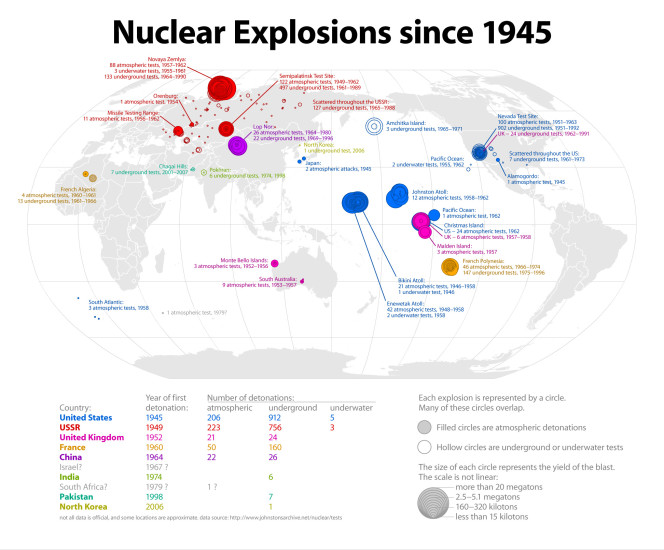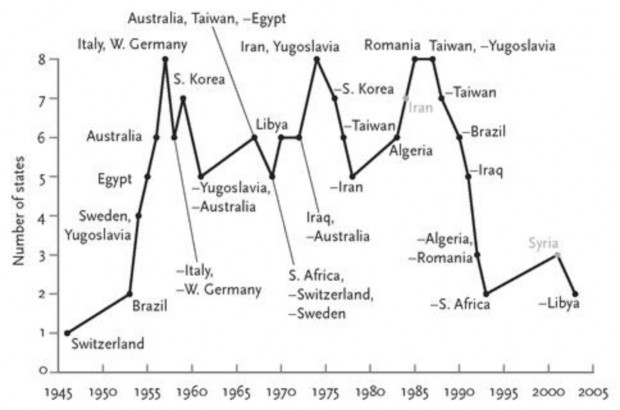Notice: This is only a preliminary collection of relevant material
The data and research currently presented here is a preliminary collection or relevant material. We will further develop our work on this topic in the future (to cover it in the same detail as for example our entry on World Population Growth).
If you have expertise in this area and would like to contribute, apply here to join us as a researcher.
The world’s nuclear powers have more than 10,000 nuclear warheads in their arsenals. These weapons have the capacity to kill millions directly and through their impact on agriculture have likely the potential to kill billions.1
Nuclear weapons technology was developed during the 1930s and 1940s. The first nuclear weapons were detonated over Hiroshima and Nagasaki in August 1945. Since then, controlling the proliferation of nuclear weapons has been an important issue in international relations and the two detonations in Japan remained the only ever usage in warfare
All our charts on Nuclear Weapons
One way of quantifying the proliferation of nuclear weapons is to look at the stockpiles countries have. The number of states with confirmed nuclear capabilities now includes the US, Russia, UK, France, China, India, Pakistan, Israel and North Korea.2
This chart shows that the total number of nuclear weapons in the world peaked in 1986. It is, however, worth remembering that the destructive power of each nuclear warhead has increased significantly since the first atomic weapons used in the Second World War.
If we consider the number of nuclear weapons tests, we can see that the Cold War was a very active period of nuclear weapons development. Although nuclear weapons were only ever used in warfare during the Second World War, there have been over 2000 nuclear weapons tests since then. Most recently North Korea conducted nuclear weapons tests in 2006, 2009 and 2013.
World map of nuclear weapons test
The location of these nuclear weapons tests is shown on this world map by cartographer Bill Rankin.
World map of nuclear explosions, 1945-2007 – Bill Rankin (2007)3

It is a common misconception that more and more nations are exploring and developing nuclear weapons since the Second World War. As the graph demonstrates, there have been peaks in nuclear weapon development in the past few decades. By the late 1980s, the number of nations developing nuclear weapons started falling and has remained steady since the mid-1990s.
The names in the graph represent nations developing weapons, and countries marked with “-” represent the year in which development in that country ceased.
Non-nuclear states that started and stopped exploring nuclear weapons, 1945-2010 – Pinker4

Obtaining an accurate count of the nuclear warheads possessed by each country today is difficult, since each country controls the publicly available information relating to its nuclear capabilities for security reasons. The data presented here is taken from the Federation of American Scientists Nuclear Notebook and should be taken as a best-estimate of the capabilities of each country. In addition to this, Israel maintains a policy of nuclear ambiguity and refuses to confirm or deny its nuclear capabilities.
The data on nuclear weapons tests come from the Oklohoma Geological Survey and can be considered an accurate count of nuclear weapons tests.
- Data: Estimate of the nuclear warhead inventory and capability of each nuclear power
- Geographical coverage: Confirmed and suspected nuclear powers
- Time span: 1945-2014
- Available at: Online here
- Data: Nuclear tests, above ground nuclear detonations, high-altitude nuclear explosions and fatalities
- Geographical coverage: Global
- Time span: Since 1945
- Available at: Online here
- Data: Depth, magnitude, latitude and longitude of nuclear explosions
- Geographical coverage: Global
- Time span: 1945-1998
- Available at: Online here